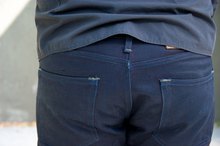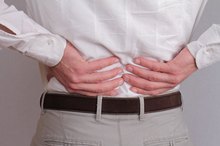Bruised Tailbone Remedies
A comedic pratfall invariably elicits audience laughter, but a bruised tailbone is no laughing matter. Falling backward onto your bottom or a blow to the tailbone incurred during sports activities can leave you with a painful bruised tailbone, or coccyx. In most cases, simple treatments and lifestyle adjustments offer pain relief until the injury heals.
If you are experiencing serious medical symptoms, seek emergency treatment immediately.
Cold and Warm Packs
Applying an ice or cold pack to your bruised tailbone for the first 24 to 48 hours after the injury can help relieve your pain and limit swelling in the area 4. Ice packs can be used for 15 to 20 minutes at a time, and applied as often as needed as long as you allow the skin to rewarm between applications.
After the first 48 hours, most people find use of a warm compress, hot pack or heating pad more soothing. Running warm water over your tailbone with a handheld shower head or floating in a hot tub can also provide temporary pain relief 4.
- Applying an ice or cold pack to your bruised tailbone for the first 24 to 48 hours after the injury can help relieve your pain and limit swelling in the area 4.
- Running warm water over your tailbone with a handheld shower head or floating in a hot tub can also provide temporary pain relief 4.
Over-The-Counter Pain Relievers
How to Treat a Deep Bone Bruise of the Knee
Learn More
Over-the-counter pain relievers can be useful in the first few days after bruising your tailbone, if you don't have a medical condition that precludes use of these medicines 4. Options include aspirin, ibuprofen (Advil, Motrin) and naproxen (Aleve). If you're not sure whether these medications are safe for you, call your doctor. Prescription pain medications are rarely necessary for a bruised tailbone 4.
Modified Activities
When you have a bruised tailbone, you might need to modify your activities for a few weeks to avoid putting pressure on the area. Examples of activities you'll likely want to avoid include cycling, spinning classes, horseback riding, and riding on a motorcycle. As a rule of thumb, if it hurts, don't do it.
Tailbone Cushion
Fractured Tailbone While Snowboarding
Learn More
When you have a bruised tailbone, it's best to avoid sitting as much as possible -- especially on hard surfaces -- until the soreness subsides. But avoiding sitting entirely is impossible for most people. Using a tailbone cushion can make sitting more comfortable and prevent further irritation of the bruised area. These cushions keep pressure off your tailbone while sitting. Tailbone cushions, also known as donut or coccyx pillows, are relatively inexpensive and can be purchased at most pharmacies and online. If your work requires you to sit, frequent standing or walking breaks can help keep you comfortable.
- When you have a bruised tailbone, it's best to avoid sitting as much as possible -- especially on hard surfaces -- until the soreness subsides.
- If your work requires you to sit, frequent standing or walking breaks can help keep you comfortable.
A bruised tailbone typically heals in a couple of weeks. If your pain is severe, persists or gets worse, see your doctor. Also seek medical care if your tailbone pain is accompanied by other symptoms, such as a rash on the buttocks, leg pain or a change in bowel habits 4. This is important because coccyx pain occurs with conditions other than a bruised tailbone 4.
Review and revised by: Tina M. St. John, M.D.
- A bruised tailbone typically heals in a couple of weeks.
- Also seek medical care if your tailbone pain is accompanied by other symptoms, such as a rash on the buttocks, leg pain or a change in bowel habits 4.
Related Articles
References
- Evidence-Based Interventional Pain Practice According to Clinical Diagnosis; Jan Van Zundert, et al.
- Atlas of Common Pain Syndromes, 3rd Edition; Steven D. Waldman
- Problem-Based Pain Management; Eric S. Hsu, et al.
- NHS Choices: Coccydynia (Tailbone Pain)
- Essentials of Physical Medicine and Rehabilitation, 3rd Edition; Walter R. Frontera, et al.
- Blocker O, Hill S, Woodacre T. Persistent coccydynia--the importance of a differential diagnosis. BMJ Case Rep. 2011;2011:bcr0620114408. doi:10.1136/bcr.06.2011.4408
- Foye PM, Abdelshahed DM, Kamrava E, Enriquez R, D'onofrio GJ. Tailbone Pain from Coccyx Injuries on Water Slides: A Case Series. J Emerg Med. 2018;55(2):e33-e35. doi:10.1016/j.jemermed.2018.04.033
- Young JD, Gelbs JC, Zhu DS, Gallacher SE, Sutton KM, Blaine TA. Orthopaedic Injuries in Equestrian Sports: A Current Concepts Review. Orthop J Sports Med. 2015;3(9):2325967115603924. doi:10.1177/2325967115603924
- Márquez-carrasco ÁM, García-garcía E, Aragúndez-marcos MP. Coccyx pain in women after childbirth. Enferm Clin. 2019;29(4):245-247. doi:10.1016/j.enfcli.2019.01.005
- Gonnade N, Mehta N, Khera PS, Kumar D, Rajagopal R, Sharma PK. Ganglion impar block in patients with chronic coccydynia. Indian J Radiol Imaging. 2017;27(3):324–328. doi:10.4103/ijri.IJRI_294_16
- Faubion SS, Shuster LT, Bharucha AE. Recognition and management of nonrelaxing pelvic floor dysfunction. Mayo Clin Proc. 2012;87(2):187–193. doi:10.1016/j.mayocp.2011.09.004
- Uglialoro AD, Beebe KS, Hameed M, Benevenia J. A rare case of intraosseous benign notochordal cell tumor of the coccyx. Orthopedics. 2009;32(6):445. doi:10.3928/01477447-20090511-22
- Nunes LF, Castro Neto AK, Vasconcelos RA, et al. Carcinomatous degeneration of pilonidal cyst with sacrum destruction and invasion of the rectum. An Bras Dermatol. 2013;88(6 Suppl 1):59–62. doi:10.1590/abd1806-4841.20132140
- Dudareva M, Ferguson J, Riley N, Stubbs D, Atkins B, McNally M. Osteomyelitis of the Pelvic Bones: A Multidisciplinary Approach to Treatment. J Bone Jt Infect. 2017;2(4):184–193. doi:10.7150/jbji.21692
- Saleem S, Aslam HM, Rehmani MA, Raees A, Alvi AA, Ashraf J. Lumbar disc degenerative disease: disc degeneration symptoms and magnetic resonance image findings. Asian Spine J. 2013;7(4):322–334. doi:10.4184/asj.2013.7.4.322
- Jeyarajah S, Purkayastha S. Proctalgia fugax. CMAJ. 2013;185(5):417. doi:10.1503/cmaj.101613
- Lirette LS, Chaiban G, Tolba R, Eissa H. Coccydynia: an overview of the anatomy, etiology, and treatment of coccyx pain. Ochsner J. 2014;14(1):84–87.
- Malanga GA, Yan N, Stark J. Mechanisms and efficacy of heat and cold therapies for musculoskeletal injury. Postgrad Med. 2015;127(1):57-65. doi:10.1080/00325481.2015.992719
- Scott KM, Fisher LW, Bernstein IH, Bradley MH. The Treatment of Chronic Coccydynia and Postcoccygectomy Pain With Pelvic Floor Physical Therapy. PM R. 2017;9(4):367-376. doi:10.1016/j.pmrj.2016.08.007
- Antoniadis A, Ulrich NH, Senyurt H. Coccygectomy as a surgical option in the treatment of chronic traumatic coccygodynia: a single-center experience and literature review. Asian Spine J. 2014;8(6):705–710. doi:10.4184/asj.2014.8.6.705
- Foye PM. Coccydynia: Tailbone Pain. Phys Med Rehabil Clin N Am. 2017 Aug;28(3):539-49.
- Lirette LS, Chaiban G, Tolba R, Eissa H. Coccydynia: An Overview of the Anatomy, Etiology, and Treatment of Coccyx Pain. Ochsner J. 2014 Spring;14(1):84-87.
- Nathan ST, Fisher BE, Roberts CS. Coccydynia: a review of pathoanatomy, aetiology, treatment and outcome. J Bone Joint Surg Br. 2010 Dec;92(12):1622-7.
Writer Bio
Beth Richards, a freelance writer since 2002, writes about health and draws from her 25 years as a licensed dispensing optician. She has authored several books, writes for national magazines including "Country Living" and "Organic Family" and is a health and wellness features writer for several publications. She is earning a Bachelor of Arts in English from the University of Maryland.









